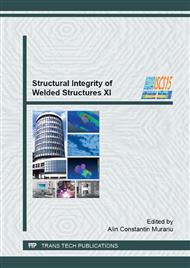[1]
Bordeaşu I., Eroziunea cavitaţională a materialelor, Editura Politehnica Timişoara, ISBN: (10)973-625-278-7; (13)978-973-625-278-5, (2006).
Google Scholar
[2]
Bordeaşu, I., Mitelea, I., Katona, S.E., Considerations regarding the behavior of some austenitic stainless steels to cavitation erosion. METAL 2012, 21th International Conference on Metallurgy and Materials, May 23-25, Brno, Czech Republic, pp.730-735, (2012).
Google Scholar
[3]
Bordeaşu I., Popoviciu M.O., Micu Lavinia Mădălina, Sălcianu Laura, Bordeaşu C. - Cavitation erosion researches upon two AMPCO bronzes, "The Eighth International Symposium KOD 2014 Machine and Industrial Design in Mechanical Engineering Proceedings, 12-15 june 2014, Hotel Marina, Balatonfured, Hungary, (2014).
Google Scholar
[4]
Espitia A.L., Toro A. - Cavitation resistance, microstructure and surface topography of materials used for hydraulic components. Tribology International, 43, (2010), p.2037 – (2045).
DOI: 10.1016/j.triboint.2010.05.009
Google Scholar
[5]
Franc, J., P., Michel, J., M., - Fundamentals of cavitation, Kluwer Academic Publishers- Dordrecht/Boston/London, (2004).
Google Scholar
[6]
Hammitt F.G., M. De, J. He, Okada, B-H. Sun, Scale effects of cavitation including damage scale effects, Conf. Cavitation, Michigan, Report No. UMICH, 014456 - 75 - I, (1980).
Google Scholar
[7]
Jurchela A.D., Bordeaşu I., Karabenciov A., Oancă O., Cavitation resistance of stainless steels with constant chromium and carbon content, The 15th International Conference Modern Technologies, Quality and Innovation, ModTech 2011, Vadul lui Vodă, Chişinău, Republica Moldova, vol. I, pp.549-552; (2011).
Google Scholar
[8]
Micu Lavinia Mădălina, Bordeaşu I., Mitelea I., Ghera C., Sălcianu Laura, Cercetarea eroziunii cavitaţionale asupra oţelului inoxidabil X2CrNiMn22-5-3 tratat termic, Ştiinţă şi Inginerie, an XIV, vol. 26/2014, Sebeş Alba, ISSN: 2067-7138, Editura AGIR, Bucureşti, (2014).
Google Scholar
[9]
Mitelea, I., Bordeaşu, I., Hadăr, A., The Effect of Nickel Content Upon Cavitation Erosion for Stainless Steels with 13% Chromium and less than 0, 1% Carbon, Revista de Chimie, Chemical Abstracts RCBUAU 56(11), pp.1169-1174, ISSN: 0034-7752, (2005).
Google Scholar
[10]
Mitelea, I., Ştiinţa materialelor, vol. I, Editura Politehnica, ISBN 978-973-625-826-8, (2009).
Google Scholar
[11]
**, Standard method of vibratory cavitation erosion test, ASTM, Standard G 32, (2010).
Google Scholar


